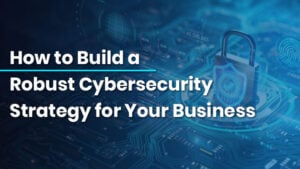
Google Workspace vs. Microsoft 365: Which is Better for Your Team?
Google Workspace vs. Microsoft 365: Which is Better for Your Team? Introduction Choosing the right productivity suite is essential for any business aiming to
🔥 Limited Time Offer 🔥 Get the Premium Monthly Plan for just $11.99 $19.99. Use code UPSKILLNOW and unlock exclusive benefits 👉Subscribe Now!

Google Workspace vs. Microsoft 365: Which is Better for Your Team? Introduction Choosing the right productivity suite is essential for any business aiming to

How to Build a Robust Cybersecurity Strategy for Your Business Introduction In the modern digital landscape, cybersecurity is no longer just an IT concern,

What Does It Mean to Humanize Healthcare AI? Introduction The emergence of Artificial Intelligence (AI) in medicine is revolutionizing the sector at an unprecedented
Table of Contents
In the digital age, where data is the new gold, cyber threats loom large, presenting a constant and evolving challenge for businesses of all sizes. To combat these threats, an enterprise cybersecurity framework is no longer a luxury but a necessity. It is the foundation for robust defenses, protecting valuable assets and ensuring business continuity.
But how do you build a framework that truly works for your organization? This blog post will guide you through the critical steps in constructing a practical enterprise cybersecurity framework.
Dive deeper into the world of cloud technology and IT mastery with IPSpecialist! Get the best course by accessing comprehensive IT certification training and resources. From beginner-level IT courses to mastering Cloud Computing, Cybersecurity, DevOps, Microsoft, and more, IPSpecialist offers diverse courses, study guides, and practice exams tailored to amplify your skills. Elevate your career in the dynamic realm of IT—explore their offerings now!
The Cybersecurity Framework is a set of pre-existing policies and procedures developed by leading cybersecurity organizations. Its purpose is to strengthen cybersecurity strategies in the business environment. These are proven theoretical knowledge and practical procedures. These models are often built for a specific industry to minimize unnamed configuration errors in the enterprise’s information network.
To simplify, the Cybersecurity Framework is a pre-designed model to enhance information security for your business.
Five steps comprise a Cybersecurity Framework: Identification, Protection, Detection, Respond, and Remediation. Any network security model can apply this process.
Here are the details of each step in the process:
This step helps businesses identify network connection points in the business environment. It can be information technology devices, resources, information, etc.
This step strengthens access control, data security, and maintenance in and around the business environment. It can be understood as a proactive phase of problem-solving in network security.
This step is when businesses will find and detect potential vulnerabilities by monitoring logs and intrusions at the network and device levels. They will carry out both operational management and security information.
Once a vulnerability has been discovered, businesses need to respond quickly. Understand the vulnerability, fix the flaws, and proceed with the remediation process.
Remediating the cybersecurity process, as well as troubleshooting and contingency planning, will be handled during this phase.
Establishing a comprehensive cybersecurity framework involves developing and implementing well-defined security policies and procedures within an organization. These policies cover various aspects, including information classification, access control, network and endpoint security, incident response, and compliance with legal and regulatory requirements. The framework addresses data privacy, vendor management, and security awareness training issues. Regular reviews, updates, and enforcement mechanisms are crucial to ensuring the effectiveness of these policies in mitigating risks and adapting to emerging threats. The documentation of security measures, communication plans, and a structured governance framework contribute to building a resilient and adaptable cybersecurity posture for the enterprise.
After determining the suitable cybersecurity model for the business, the implementation process needs to be followed according to the guidelines. Here are some steps to take to start and maintain this process.
The Cybersecurity Framework is critical in fortifying and responding to unexpected cyber scenarios. It helps keep businesses from falling victim to cybercrime.
Businesses need to understand the requirements they need to meet clearly. After discussing with stakeholders and the IT department, they must also analyze the implementation process.
The demand for enterprise cybersecurity frameworks in 2024 is undoubtedly high and expected to continue rising.
Nowadays, cyber-attacks are becoming more and more sophisticated. Thus, businesses should adopt a suitable Cybersecurity Framework to build a solid defense against hackers.
Deciding to build a framework is 50% successful in complying with security standards. However, that model must be maintained to produce the expected results for the network security system of an enterprise, thereby securing the information of businesses and customers.
By following mentioned vital steps, your organization can create a robust defense against cyber threats, protecting both sensitive data and the overall integrity of your business operations. Remember, cybersecurity is a shared responsibility that requires continuous effort and collaboration across all levels of the organization.
Answer: A framework in cybersecurity is a structured set of guidelines and best practices, like NIST CSF or ISO/IEC 27001, designed to manage and enhance an organization’s security posture.
Answer: Enterprise security architecture development involves risk assessment, defining security requirements, selecting controls, architecture design, implementation, monitoring, documentation, and incident response planning to mitigate risks and protect assets.
Answer: Five steps comprise a Cybersecurity Framework:
Any network security model can apply this process.
© 2025 All rights reserved | Privacy Policy | Terms and Conditions | Sitemap | Cookie Policy




